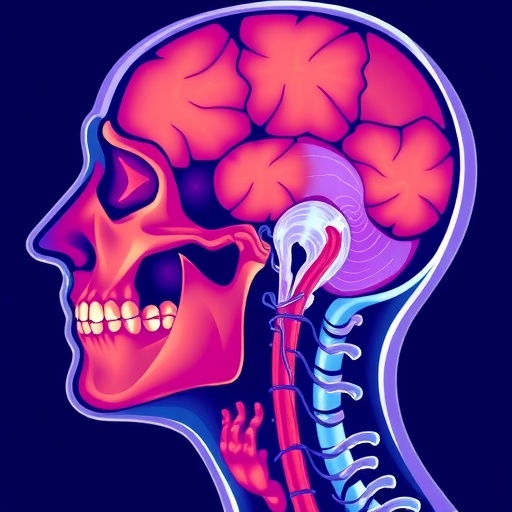In a groundbreaking study published in BMC Cancer, researchers have developed a highly predictive nomogram model designed to assess the severity of radiation dermatitis (RD) in patients with locally advanced head and neck cancer (HNC) undergoing concurrent chemoradiotherapy. Radiation dermatitis poses a significant clinical challenge due to the heightened sensitivity of the skin in the head and neck region to radiation exposure. This novel model combines subjective and objective measurements to offer a more accurate prediction tool for clinicians, potentially transforming patient management in radiotherapy settings.
Head and neck cancers remain a formidable medical challenge, frequently requiring aggressive treatment modalities such as intensity-modulated radiotherapy (IMRT) combined with chemotherapy. While these treatments improve survival, they often result in considerable side effects, with radiation dermatitis being among the most common and debilitating. Severe RD can lead to treatment interruptions, impaired quality of life, and increased risk of infection. Consequently, early prediction and quantification of RD severity are vital in optimizing therapeutic strategies and mitigating adverse effects.
The investigative team conducted a comprehensive study over a period extending from May 2020 through December 2023, enrolling 257 HNC patients who received IMRT alongside concurrent chemotherapy. These patients were stratified into training and validation cohorts at a ratio of 7:3 to ensure robust model validation. The research focused on the application of the Late Effects Normal Tissue Task Force-Subjective, Objective, Management, Analytic (LENT-SOMA) scale, a comprehensive assessment tool that captures both patient-reported outcomes and clinical evaluations of late radiation effects.
A novel aspect of this study was the correlation analysis between early LENT-SOMA scores and other established acute RD grading systems, including the Radiation Therapy Oncology Group (RTOG), Common Terminology Criteria for Adverse Events (CTCAE), World Health Organization (WHO), and Oncology Nursing Society (ONS) criteria. This rigorous validation confirmed the reliability of early LENT-SOMA scores in reflecting acute radiation-induced skin toxicity, reinforcing its utility as a predictive endpoint.
The research team utilized logistic regression analyses to identify hematological parameters with prognostic relevance. The multivariate analysis revealed that elevated pre-radiotherapy lymphocyte counts and blood glucose levels, combined with decreased fibrinogen and albumin levels, independently predicted higher LENT-SOMA scores indicative of more severe RD. These biomarkers likely reflect underlying immunologic, inflammatory, and nutritional statuses modulating individual radiosensitivity and tissue repair mechanisms.
Integrating these hematological predictors, the investigators constructed a visual nomogram model—a statistically rigorous, user-friendly graphical calculator—that demonstrated superior discriminatory power in predicting grade 2 or greater radiation dermatitis. The model’s performance was quantitatively validated using receiver operating characteristic (ROC) curves, with an area under the curve (AUC) attesting to its high sensitivity and specificity in both training and validation cohorts.
Calibrations assessing agreement between predicted and observed RD incidences further confirmed the nomogram’s accuracy, while decision curve analysis underscored its potential clinical utility by demonstrating net benefit across a range of threshold probabilities. Together, these validation steps endorse the nomogram as a promising personalized medicine tool to guide clinicians in tailoring skin-protective interventions or modifying treatment plans.
The implications of this research extend beyond mere prediction. By highlighting the intricate interplay between systemic hematologic factors and radiation-induced skin toxicity, this study invites deeper exploration into the mechanisms of tissue radiosensitivity. For instance, lymphocytes play crucial roles in immune surveillance and inflammatory responses, which influence tissue damage and repair. Elevated blood glucose has been linked to impaired wound healing and increased oxidative stress, while fibrinogen and albumin levels serve as markers of coagulation status and nutritional health, respectively, both critical to skin integrity and recovery.
Moreover, the utilization of the LENT-SOMA scale offers a holistic avenue for evaluating radiation toxicities, blending objective clinical signs with patient-experienced symptoms. This multidimensional assessment surpasses traditional evaluator-centric grading systems, fostering a patient-centered approach in radiation oncology.
Clinicians engaged in the multidisciplinary care of head and neck cancer patients stand to benefit immensely from this predictive model. The ability to stratify patients based on risk for severe RD can inform pre-emptive measures such as enhanced skin care protocols, targeted nutritional support, or adjustment of radiation dosing schedules. Ultimately, this could reduce morbidity, maintain treatment adherence, and improve survivors’ quality of life.
The study’s extensive cohort and longitudinal design add credibility and relevance to its findings, though prospective external validation in diverse populations and treatment contexts remains warranted. Future research might also explore integrating genetic or molecular markers with the identified hematologic parameters to refine predictive accuracy further.
In summary, this pioneering study articulates a scientifically robust, hematological indicators-based nomogram that leverages the LENT-SOMA scale to assess and predict radiation dermatitis severity with notable precision in head and neck cancer patients undergoing chemoradiotherapy. By integrating clinical insight with advanced statistical modeling, it sets a new standard for personalized radiation toxicity management and paves the way for improved therapeutic outcomes.
As radiation oncology continues to evolve toward tailored treatment paradigms, such innovative predictive tools afford clinicians crucial foresight, enabling interventions that could transform the patient experience. This research exemplifies the potential of translational science in harmonizing biological markers with clinical endpoints to mitigate adverse treatment effects and optimize cancer care.
Subject of Research: Prediction and assessment of radiation dermatitis severity in locally advanced head and neck cancer patients undergoing concurrent chemoradiotherapy.
Article Title: Assessment of radiation dermatitis in locally advanced head and neck cancer patients treated with concurrent chemoradiotherapy using LENT-SOMA scale: hematological indicators-based nomogram model.
Article References:
Chen, Y., Zhang, Y., Wang, X. et al. Assessment of radiation dermatitis in locally advanced head and neck cancer patients treated with concurrent chemoradiotherapy using LENT-SOMA scale: hematological indicators-based nomogram model. BMC Cancer 25, 1630 (2025). https://doi.org/10.1186/s12885-025-15032-9
Image Credits: Scienmag.com
DOI: https://doi.org/10.1186/s12885-025-15032-9
Tags: clinical implications of radiation dermatitiscomprehensive study on HNC patient outcomesconcurrent chemoradiotherapy side effectsearly prediction of radiation dermatitishead and neck cancer treatment challengesintensity-modulated radiotherapy and chemotherapyoptimizing therapeutic strategies for HNCpatient management in radiotherapypredictive nomogram for radiation dermatitisQuality of Life in Cancer Patientsseverity assessment of radiation dermatitisskin sensitivity to radiation exposure





